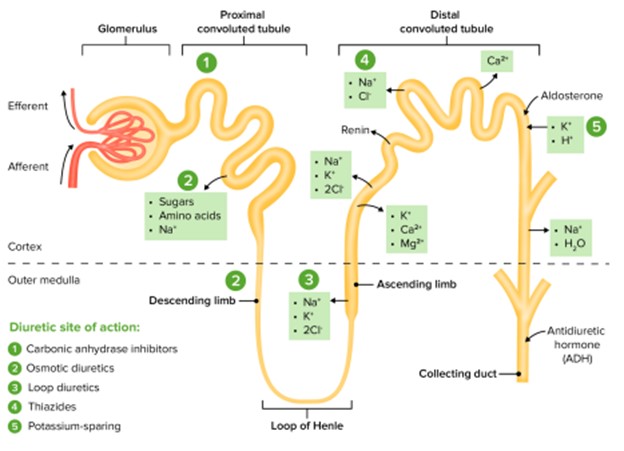An older adult is admitted to the hospital. The patient's height is 5 feet, 6 Inches (1.68M), and weigh 250 lb. (113.3kg). The nurse calculates the patient's current body mass index (BMI) as: (Round your answer to the nearest whole number.)
41.0
35.5
30.0
40.0
The Correct Answer is D
To calculate the patient's body mass index (BMI), we need to divide the weight (in kilograms) by the square of the height (in meters). Let's convert the height and weight measurements to the appropriate units and perform the calculation:
Height: 5 feet, 6 inches = 5 + (6/12) = 5.5 feet = 1.6764 meters (rounded to four decimal places) Weight: 250 lb. = 113.3 kg
BMI = Weight (kg) / (Height (m))^2
BMI = 113.3 kg / (1.6764 m)^2
BMI ≈ 40.0
Nursing Test Bank
Naxlex Comprehensive Predictor Exams
Related Questions
Correct Answer is C
Explanation
Loop diuretics, such as furosemide, are known to promote diuresis (increased urine output) and can cause electrolyte imbalances, including low potassium (hypokalemia). The patient's statement about eating a diet rich in potassium-containing foods like potatoes, bananas, avocadoes, strawberries, and spinach is incorrect in this context. These foods are indeed good sources of potassium, but when taking loop diuretics, it is necessary to monitor and potentially restrict potassium intake to prevent excessive potassium levels.
"I will weigh myself daily and report to my physician if I gain more than 3 lbs in 1 day." This statement reflects the patient's understanding of the need to monitor their weight daily as a means of assessing fluid balance. Rapid weight gain may indicate fluid retention, which should be reported to the physician.
"This medication can cause dehydration, so I will stay hydrated by consuming at least 2 L or more of fluid per day." This statement demonstrates awareness of the potential for dehydration when taking loop diuretics and the importance of staying adequately hydrated by consuming an appropriate amount of fluids.
"I will change position slowly because I can become dizzy easily while taking this medication." This statement reflects the understanding that loop diuretics can cause orthostatic hypotension,
leading to dizziness upon sudden changes in position. Taking precautions and changing position slowly can help prevent falls and related injuries.

Correct Answer is D
Explanation
Patient-centered care involves actively involving the patient in their care and considering their preferences, values, and goals. By discussing dietary preferences with the client, the nurse is demonstrating a patient-centered approach. This documentation indicates that the nurse took the time to engage in a conversation with the client to understand their dietary preferences,
which can help tailor the care plan to meet the client's individual needs and preferences. "Steady gait observed when ambulating" focuses on the nurse's observation and assessment but does not specifically involve the patient's preferences or goals.
"Social worker paged for consultation" indicates collaboration with another healthcare professional but does not necessarily reflect the patient's active involvement or preferences. "Nursing literature reviewed for best practice approaches" highlights evidence-based practice but does not directly involve the patient's preferences or engagement in decision-making.
Whether you are a student looking to ace your exams or a practicing nurse seeking to enhance your expertise , our nursing education contents will empower you with the confidence and competence to make a difference in the lives of patients and become a respected leader in the healthcare field.
Visit Naxlex, invest in your future and unlock endless possibilities with our unparalleled nursing education contents today
Report Wrong Answer on the Current Question
Do you disagree with the answer? If yes, what is your expected answer? Explain.
Kindly be descriptive with the issue you are facing.
